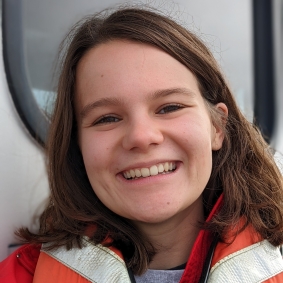Eight students will be presenting the summer work at the Ocean Sciences Meeting in March 2022!
Desa Bolger, Scripps College
Class Year:
2022Mentor:
Jeremy Testa Ph.D.Project Title:
Oyster Aquaculture and Nitrogen Cycling: Ecosystem Service Provider or Agent of Excess?Abstract:
Although many studies have examined Crassostrea virginica, also known as the Eastern oyster, and its relationship to the nitrogen cycle, few have studied nitrogen cycling in aquaculture settings through on-bottom aquaculture. As aquaculture is on the rise in the United States (Ray et al. 2021), a better understanding of these impacts may allow for the promotion of nitrogen crediting systems regarding the oysters’ ability to reduce eutrophication (Newell 1988). We hypothesized that Eastern oysters in on-bottom cages in high-energy farms have limited effects on nitrogen cycling, due to high flow rates dispersing biodeposits. Through sediment-water fluxes, porewater collections, and surface sediment samples, we quantified the impacts of oyster aquaculture off the coast of Solomons Island, MD.
Although no sizable difference between the percent carbon and percent nitrogen levels in the sediment was detected, sediment-water fluxes and porewater samples did show dramatic changes. Heightened levels of oxygen, ammonium, and nitrite fluxes suggested an amplification of biodeposits under the cages, and porewater data showed sulfide and ammonium levels were consistently higher in the farm. Furthermore, these data show ammonium and sulfide levels increasing with depth, which peaked in the summer.
Overall, this study suggests that high-flow oyster aquaculture farms concentrate
biodeposits, leading to elevated nitrogen and phosphorous concentrations, increased respiration and ammonium fluxes, and higher sulfide accumulation. This study suggests a decrease in nitrification and an increase in denitrification under cages, allowing for both the enhancement of nitrogen loss and recycling on the farm. These conclusions did not support our hypothesis that high energy conditions will limit a farm’s effect on nitrogen cycling. Future studies including larger sample sizes and tracking the impacts of cages versus bags should also be investigated, as these tests may continue to show support for implementing oyster aquaculture in nitrogen crediting systems.
Location:
Chesapeake Biological LaboratoryREU Update
Masters student in Environmental Management at Duke University. Co-director of SkyDay.Presentations:
Testa, J., D. Bolger*, C. Gurbisz, and C. Hodgkins. 2023. Oyster aquaculture and nitrogen cycling: ecosystem service provider or agent of excess?. Coastal Estuarine Research Federation Biennial Meeting, Portland, OR.




